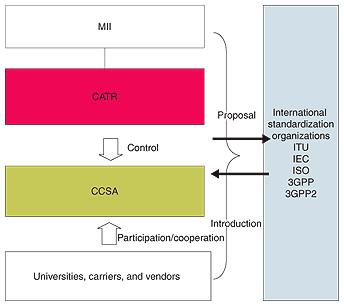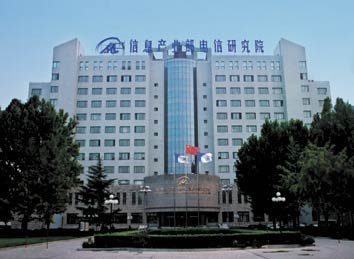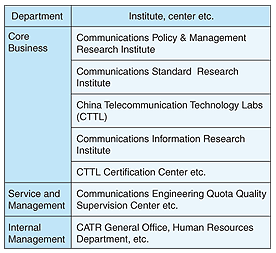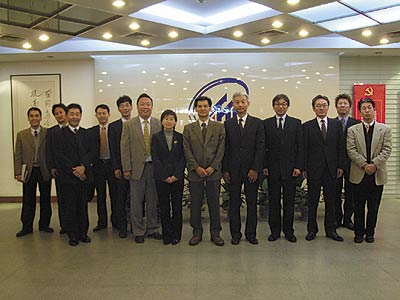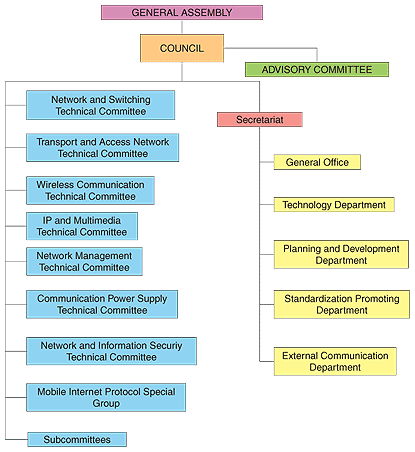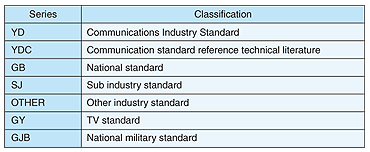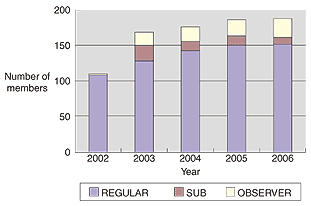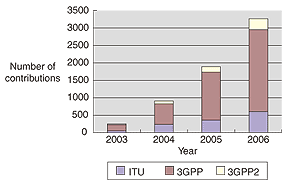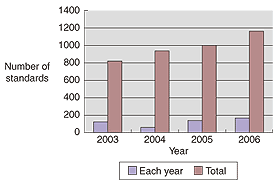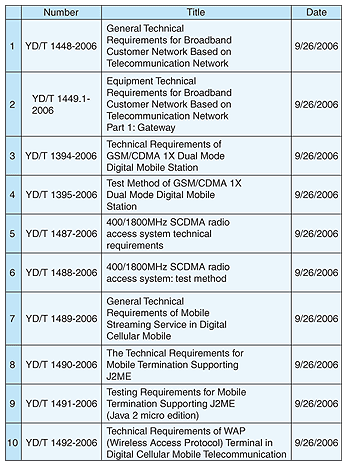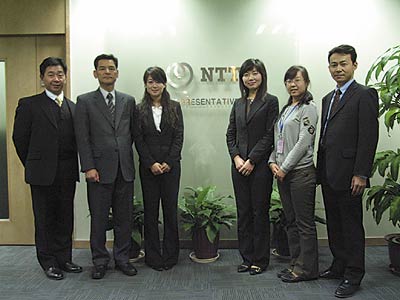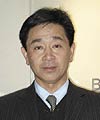 |
|||||||||||||
|
|
|||||||||||||
|
Global Standardization Activities Vol. 5, No. 5, pp. 34–41, May 2007. https://doi.org/10.53829/ntr200705gls Recent Telecommunication Standardization Activities in ChinaAbstractThis article introduces recent telecommunication standardization activities in China and outlines the key players: CATR (China Academy of Telecommunication Research) and CCSA (China Communications Standards Association). Finally, future topics related to telecommunication standardization in China are mentioned.
1. IntroductionThe NTT Beijing Representative Office was opened in April 2006. This office was established to implement the global aspects of the NTT Group's Medium-Term Management Strategy. With the Beijing Olympics being held in 2008 and the Shanghai World Expo in 2010, China offers exciting growth opportunities, so NTT decided to establish an office in Beijing, which will be the uniform point of contact for the Chinese government and Chinese businesses. This should strengthen our efforts in this market as we work in unified collaboration with local subsidiaries of NTT Group, such as NTT Communications, NTT DoCoMo, NTT Facilities, and NTT Electronics. This article reports on telecommunication standardization activities in China. 2. Structure of telecommunication standardization in China
The structure of telecommunication standardization in China is shown in Fig. 1. The key players are the China Academy of Telecommunication Research (CATR) [1], which is a government research institute operated by the Ministry of Information Industry (MII) [2], and China Communications Standards Association (CCSA) [3], which is also under the direction of MII. Other important entities involved in telecommunication standardization are telecommunication carriers, vendors, and universities. MII is responsible for deciding telecommunication laws and setting standards for industries. It is equivalent to the Ministry of Internal Affairs and Communication in Japan. CATR is an important department in MII. It conducts research, makes proposals, and advises MII on telecommunication laws and regulations. It also makes technical standards and provides several evaluation and certification services for equipment or systems. CCSA is the only national certified standardization body that deals with proposals from CATR or with ITU/IEC documents to introduce them into the national or international area. CCSA has published many standards documents for telecommunication industrial standards and national standards. The original plans for standards documents are normally proposed by CATR. They are then discussed in a Working Group of a Technical Committee in CCSA, whose members come from CATR itself, national experimental laboratories, telecommunication carriers, domestic universities, vendors, and so on. After the discussions, telecommunication technical standards and associated testing methods and equipment requirements are published. The following sections introduce CATR and CCSA and mention future subjects to enable a clear understanding of recent telecommunication standards activities in China. 3. CATR3.1 Overview
CATR (Photo 1) is located in the northwest part of Beijing. Its predecessor was the Posts and Telecommunications Academy, established in 1956 by the former MPT (Ministry of Posts and Telecommunications). The current CATR was established in 1994, as the result of a reorganization, from components such as the Research Institute of Transmission Technology (RITT), the Planning Institute, the Information Institute, the Communications Measurement Center, and the Industrial Standardization Institute. From the beginning, its mission has been to support the government and serve industry. Its organization is shown in Table 1.
Although it is only one of many MII institutes, its responsibilities are wide ranging and important for telecommunication standardization and it makes decisions for nationwide requirements. CATR has more than 12 laboratories, such as the Communication Standards Research Institute and the Planning and Design Research Institute. Its staff of about 800 includes over 200 with master's or higher degrees, more than 300 with senior technical professional titles, and over 40 who are experts receiving special government allowances. A photograph taken during our visit to CATR in November 2006 is shown in Photo 2. The general manager of the NTT Beijing Representative Office, Mr. Masaki, is standing in the center, with Ms. Liu (Director, Communications Standard Research Institute) on the left and Dr. Yan (Director, CATR) on the right.
3.2 Missions of CATRTo better perform its function of supporting government work, CATR provides direct and professional research reports or timely information on science and technology and other data, gets deeply involved in discussions and investigations, and supports the government in its decision-making. (1) Standardization and study of policy CATR has been supporting the Chinese government, such as the national standards administration and MII, to decide upon strategies and make laws/regulations in the telecommunication area. It also provides technical standards in response to the rapid progress of industrial development. CATR has several series of technical standards. The telecommunication industrial standards (YD series), for example, number more than 1200. Original ideas for technical standards are proposed by CATR members, usually CATR researchers, and the proposed documents are deliberated in CCSA. Participants in these deliberations also include telecommunication carriers, national experimental laboratories, domestic universities, and vendors (both domestic and foreign companies). CATR also studies new telecommunication technical areas and contributes to the development and progress of China's telecommunication network. Recent research areas include 3G (third generation) and Beyond 3G, NGN (Next Generation Network), FTTH (fiber to the home), and IPTV (Internet protocol television). (2) Tests and trials of communications products and measurements of telecommunications equipment Besides producing regulations, CATR also provides certification and testing services. It built the world's only national mobile network simulation laboratory (MTNET) with experimental networks for GSM (global system for mobile communications) and CDMA (code division multiple access) and a simulated 3G network for testing 3G systems. MTNET can also be used for testing mobile CDG (CDMA Development Group) and RF (radio frequency) interfaces as well as for overvoltage and overcurrent testing and mobile switching equipment and mobile simulation test systems. In 1999, CATR established EMC (electromagnetic compatibility) test sites—one site with a 10-m chamber and two sites with 3-m chambers—to cover the frequency range from 9 kHz to 40 GHz. The laboratory has been approved by Europe and North America, and products tested in it can be exported directly to Europe and North America. EMC certification services are also available. To date, CATR has tested all kinds of telecommunication equipment including telephones, faxes, and PBXs (private branch exchanges). It has one state-authorized quality inspection center and five ministry-authorized quality inspection centers. (3) Information services CATR researches and also reports on worldwide telecommunication trends of policies, development plans, management policies, and marketing to support decisions on telecommunication development strategy, technical developments, and network operation in China. Its subsidiary companies publish many journals such as "Modern Telecommunication Science and Technology of Telecommunications" and "Telecommunication World". 4. CCSA4.1 OverviewCCSA was established in Beijing on December 18, 2002 as a nonprofit organization in the area of telecommunications. Its members include telecommunication carriers, national experimental laboratories, universities, equipment/system vendors, and representatives from CATR. Its main missions are to establish and implement telecommunication standards and requirements in conjunction with telecommunication carriers, universities, national experimental laboratories, and vendors interested in standardization. It also provides several services, including an impartial certification service and an EMC testing service to customers. Another mission is to recommend high-level and high-quality standards to the Chinese government and spread standards based on Chinese intellectual property and to support Chinese industries and contribute to the telecommunication industries of the world.
The organization of CCSA is shown in Fig. 2. There are nine technical committees (TCs). The main roles of CCSA are as follows. (1) Make proposals for laws/regulations and political policies for the Chinese government with respect to standardization and pass on the opinions and requests of members to the administrative entities in charge and promote communication between the administration and CCSA members. (2) Study telecommunication standards and technical research, propose new and revised telecommunication standards and draft original standards documents, collect opinions, perform coordination activities, examine documents, and perform certification and mutual connection testing. (3) Advertise technical standards, provide consultation and training services, and promote the utilization of telecommunication standards. More than 1000 technical standards have been established under the Technical Committees. Recently, many standards related to TD-SCDMA (time division synchronous code division multiple access), IPTV, IPsec (Internet protocol security), and G-PON (gigabit passive optical network) have been proposed and triple-play services,* are being promoted aggressively in China. 4.2 Statistics about industrial standardsIn China, many industrial standards are still in preparation [4]. These documents are managed by classification codes. The codes used for technical standards in the telecommunication area in China are listed in Table 2.
The YD series are so-called industrial standards published by CATR after CCSA was established; these documents are managed by CCSA on behalf of CATR. The numbers of CCSA members and contributions to international standardization bodies such as ITU (International Telecommunication Union), IEC (International Electrotechnical commission), and 3GPP (3rd Generation Partnership Project), are shown in Figs. 3 and 4. Both numbers have been rising steadily every year. In particular, the number of foreign companies that are members of CCSA has risen significantly. At present, NTT and NTT DoCoMo are participating in Working Groups TC3 on NGN and TC5 on B3G/wireless LAN (local area network) of the Wireless Communication Technical Committee, respectively. The number of contributions related to 3GPP and 3GPP2 in particular have increased with the coming of the third-generation mobile phone era, as shown in Fig. 4. Contributions related to 3GPP accounted for 80% of the total contributions to international bodies. The trend of the number of telecommunication industrial standards is shown in Fig. 5. About 200 standards are published per year. As an example, the YD series is shown in Table 3.
One indication of China's prominence on the international scene was the election of Houlin Zhao as Deputy Secretary-General of ITU at the end of 2006. The number of Chinese contributions to international bodies is still increasing, reflecting China's desire to reinforce standardization activities. 4.3 Next notable standardization areas in ChinaIn a general meeting of CCSA held in December 2006, the president, Mr. Chu, reported the next notable standardization areas as being (i) NGN, (ii) IPTV, (iii) FMC (fixed-mobile convergence) including 3G, Beyond 3G, and wireless LANs, and (iv) IPR (intellectual property rights) management. He also indicated the following points as being important: reinforcement for international and national standardization activities, collaboration with global telecommunication industries because of a lack of patent technology, and promotion of contributions from foreign members.
5. ConclusionSince its accession to the WTO (World Trade Organization) in December 2001, China has striven to reinforce standardization and IPR management activities and move forward quickly by collaborating with overseas telecommunication carriers and vendors. Keeping its eyes on the Chinese market, especially the telecommunications market, the NTT Beijing Representative Office (Photo 3) hope to find ways to strengthen the collaboration between NTT and Chinese ICT (information and communications technology) industries and the Chinese government. We hope that many people, including key persons and NTT Group members in China, will visit our office and exchange information with us to accelerate the standardization of NTT's new technology and to promote IPR activities in China. References
|
|||||||||||||








